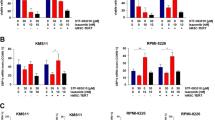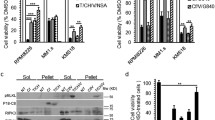Abstract
Dysfunction at any regulatory point along the apoptotic signaling pathway is closely related to many diseases including cancers. The apoptotic protein expression level is an important cause of cancer-related death, and the correct degradation of apoptotic proteins is involved in tumor development. Therefore, understanding of a regulatory point that underlying cancer-related death may help the development of new strategies to overcome the clinical challenges. Here, proteasome inhibitor Bortezomib and calpain inhibitor ALLN were examined on protein levels of caspase-3, caspase-9, XIAP, and E3-ligase PARC in HEK293T cells overexpressing XIAP and caspase-9. ATP depletion and caspase-3 activation were as a consequence of Bortezomib and ALLN function. Higher numbers of PI-stained cells provided evidence of cell death by both inhibitors. Western blotting analysis showed that both ALLN and Bortezomib equally inhibited degradation of XIAP, but only ALLN was effective at inhibiting caspase proteolytic degradation. Moreover, treatment of cells with both types of inhibitors significantly increased the level of E3-ligase PARC. Our findings showed that inhibition of proteasome and calpains enhanced the level of anti-apoptotic, XIAP and PARC, and pro-apoptotic, caspase-9 and 3 proteins, which totally promote cell death significantly.





Similar content being viewed by others
References
Reed JC. Mechanisms of apoptosis. Am J Pathol. 2000. https://doi.org/10.1016/s0002-9440(10)64779-7.
Meier P, Finch A, Evan G. Apoptosis in development. Nature. 2000;407(6805):796–801.
McConkey DJ, Orrenius S. The role of calcium in the regulation of apoptosis. J Leukoc Biol. 1996;59(6):775–83.
Srinivasula SM, Hegde R, Saleh A, et al. A conserved XIAP-interaction motif in caspase-9 and Smac/DIABLO regulates caspase activity and apoptosis. Nature. 2001. https://doi.org/10.1038/35065125.
Shiraki K, Sugimoto K, Yamanaka Y, et al. Overexpression of X-linked inhibitor of apoptosis in human hepatocellular carcinoma. Int J Mol Med. 2003. https://doi.org/10.3892/ijmm.12.5.705.
Tan Y, Wu C, De Veyra T, Greer PA. Ubiquitous calpains promote both apoptosis and survival signals in response to different cell death stimuli. J Biol Chem. 2006. https://doi.org/10.1074/jbc.M601978200.
Ciechanover A. The ubiquitin-proteasome pathway: On protein death and cell life. EMBO J. 1998;17(24):7151–60.
Crawford LJ, Walker B, Irvine AE. Proteasome inhibitors in cancer therapy. J Cell Commun Signal. 2011;14(7):417–33.
Lopes UG, Erhardt P, Yao R, Cooper GM. p53-dependent induction of apoptosis by proteasome inhibitors. J Biol Chem. 1997. https://doi.org/10.1074/jbc.272.20.12893.
Concannon CG, Koehler BF, Reimertz C, et al. Apoptosis induced by proteasome inhibition in cancer cells: predominant role of the p53/PUMA pathway. Oncogene. 2007. https://doi.org/10.1038/sj.onc.1209974.
Imajohohmi S, Kawaguchi T, Sugiyama S, et al. Lactacystin, a specific inhibitor of the proteasome, induces apoptosis in human monoblast U937 cells. Biochem Biophys Res Commun. 1995. https://doi.org/10.1006/bbrc.1995.2878.
Daniel KG, Chen D, Orlu S, et al. Clioquinol and pyrrolidine dithiocarbamate complex with copper to form proteasome inhibitors and apoptosis inducers in human breast cancer cells. Breast Cancer Res. 2005. https://doi.org/10.1186/bcr1322.
Hideshima T, Hideshima T, Richardson P, et al. The proteasome inhibitor PS-341 inhibits growth, induces apoptosis, and overcomes drug resistance in human multiple myeloma cells. Cancer Res. 2001;61(7):3071–6.
Chen D, Frezza M, Schmitt S, et al. Bortezomib as the first proteasome inhibitor anticancer drug: current status and future perspectives. Curr Cancer Drug Targets. 2011. https://doi.org/10.2174/156800911794519752.
Frankland-Searby S. Bhaumik SR (2012) The 26S proteasome complex: an attractive target for cancer therapy. Biochim Biophys Acta. 1825;1:64–76.
Sorimachi H, Ishiura S, Suzuki K. Structure and physiological function of calpains. Biochem J. 1997;328(3):721–32.
Smith MA, Schnellmann RG. Calpains, mitochondria, and apoptosis. Cardiovasc Res. 2012;96(1):32–7.
Chua BT, Guo K, Li P. Direct cleavage by the calcium-activated protease calpain can lead to inactivation of caspases. J Biol Chem. 2000. https://doi.org/10.1074/jbc.275.7.5131.
Knepper-Nicolai B, Savill J, Brown SB. Constitutive apoptosis in human neutrophils requires synergy between calpains and the proteasome downstream of caspases. J Biol Chem. 1998. https://doi.org/10.1074/jbc.273.46.30530.
Smith IJ, Dodd SL. Calpain activation causes a proteasome-dependent increase in protein degradation and inhibits the Akt signalling pathway in rat diaphragm muscle. Exp Physiol. 2007. https://doi.org/10.1113/expphysiol.2006.035790.
Call JA, Eckhardt SG, Camidge DR. Targeted manipulation of apoptosis in cancer treatment. Lancet Oncol. 2008;9(10):1002–11.
Diepstraten ST, Anderson MA, Czabotar PE, et al. The manipulation of apoptosis for cancer therapy using BH3-mimetic drugs. Nat Rev Cancer. 2022;22(1):45–64.
Mehdizadeh K, Ataei F, Hosseinkhani S. Treating MCF7 breast cancer cell with proteasome inhibitor Bortezomib restores apoptotic factors and sensitizes cell to Docetaxel. Med Oncol. 2021. https://doi.org/10.1007/s12032-021-01509-7.
Li G, Iyengar R. Calpain as an effector of the Gq signaling pathway for inhibition of Wnt/β-catenin-regulated cell proliferation. Proc Natl Acad Sci USA. 2002. https://doi.org/10.1073/pnas.202355799.
Choosakoonkriang S, Lobo BA, Koe GS, et al. Biophysical characterization of PEI/DNA complexes. J Pharm Sci. 2003. https://doi.org/10.1002/jps.10437.
Torkzadeh-Mahani M, Ataei F, Nikkhah M, Hosseinkhani S. Design and development of a whole-cell luminescent biosensor for detection of early-stage of apoptosis. Biosens Bioelectron. 2012. https://doi.org/10.1016/j.bios.2012.06.034.
Ataei F, Torkzadeh-Mahani M, Hosseinkhani S. A novel luminescent biosensor for rapid monitoring of IP3 by split-luciferase complementary assay. Biosens Bioelectron. 2013. https://doi.org/10.1016/j.bios.2012.09.037.
Salehi-Sedeh H, Ataei F, Jarchi S, et al. Effect of mutation at positively charged residues (K329 and R330) in a flexible region of firefly luciferase on structure and kinetic properties. Enzyme Microb Technol. 2019. https://doi.org/10.1016/j.enzmictec.2019.109424.
Krämer CEM, Wiechert W, Kohlheyer D. Time-resolved, single-cell analysis of induced and programmed cell death via non-invasive propidium iodide and counterstain perfusion. Sci Rep. 2016. https://doi.org/10.1038/srep32104.
Mehdizadeh K, Ataei F, Hosseinkhani S. Effects of doxorubicin and docetaxel on susceptibility to apoptosis in high expression level of survivin in HEK and HEK-S cell lines as in vitro models. Biochem Biophys Res Commun. 2020. https://doi.org/10.1016/j.bbrc.2020.08.028.
Karimzadeh S, Hosseinkhani S, Fathi A, et al. Insufficient Apaf-1 expression in early stages of neural differentiation of human embryonic stem cells might protect them from apoptosis. Eur J Cell Biol. 2018. https://doi.org/10.1016/j.ejcb.2018.01.005.
Bakhshoudeh M, Mehdizadeh K, Hosseinkhani S, Ataei F. Upregulation of apoptotic protease activating factor-1 expression correlates with anti-tumor effect of taxane drug. Med Oncol. 2021. https://doi.org/10.1007/s12032-021-01532-8.
Bratton SB, Lewis J, Butterworth M, et al. XIAP inhibition of caspase-3 preserves its association with the Apaf-1 apoptosome and prevents CD95- and Bax-induced apoptosis. Cell Death Differ. 2002. https://doi.org/10.1038/sj.cdd.4401069.
Bader M, Steller H. Regulation of cell death by the ubiquitin-proteasome system. Curr Opin Cell Biol. 2009;21(6):878–84.
Orlowski RZ. The role of the ubiquitin-proteasome pathway in apoptosis. Cell Death Differ. 1999;6(4):303–13.
Deng J, Walther A. ATP-responsive and ATP-fueled self-assembling systems and materials. Adv Mater. 2020;32(42):2002629.
Zamaraeva MV, Sabirov RZ, Maeno E, et al. Cells die with increased cytosolic ATP during apoptosis: a bioluminescence study with intracellular luciferase. Cell Death Differ. 2005. https://doi.org/10.1038/sj.cdd.4401661.
Zheng TS, Schlosser SF, Dao T, et al. Caspase-3 controls both cytoplasmic and nuclear events associated with Fas-mediated apoptosis in vivo. Proc Natl Acad Sci USA. 1998. https://doi.org/10.1073/pnas.95.23.13618.
Pei XH, Bai F, Li Z, et al. Cytoplasmic CUL9/PARC ubiquitin ligase is a tumor suppressor and promotes p53-dependent apoptosis. Cancer Res. 2011. https://doi.org/10.1158/0008-5472.CAN-10-4300.
Silke J, Hawkins CJ, Ekert PG, et al. The anti-apoptotic activity of XIAP is retained upon mutation of both the caspase 3- and caspase 9-interacting sites. J Cell Biol. 2002. https://doi.org/10.1083/jcb.200108085.
Roccaro AM, Vacca A, Ribatti D. Bortezomib in the treatment of cancer. Front Anti-Cancer Drug Discov. 2011.
Bizat N, Hermel JM, Humbert S, et al. In vivo calpain/caspase cross-talk during 3-nitropropionic acid-induced striatal degeneration: implication of a calpain-mediated cleavage of active caspase-3. J Biol Chem. 2003. https://doi.org/10.1074/jbc.M305057200.
Wójcik C. Regulation of apoptosis by the ubiquitin and proteasome pathway. J Cell Mol Med 2002;6(1):25–48.
Ozaki Y, Kato T, Kitagawa M, et al. Calpain inhibition delays neutrophil apoptosis via cyclic AMP-independent activation protein kinase A and protein kinase A-mediated stabilization of Mcl-1 and X-linked inhibitor of apoptosis (XIAP). Arch Biochem Biophys. 2008. https://doi.org/10.1016/j.abb.2008.07.001.
Woo MG, Xue K, Liu J, et al. Calpain-mediated processing of p53-associated parkin-like cytoplasmic protein (PARC) affects chemosensitivity of human ovarian cancer cells by promoting p53 subcellular trafficking. J Biol Chem. 2012. https://doi.org/10.1074/jbc.M111.314765.
Funding
This work was supported by the research council of Tarbiat Modares University.
Author information
Authors and Affiliations
Corresponding author
Ethics declarations
Conflict of interest
There is no conflict of interest to disclose.
Consent to participate
All authors agree to submit this article for publication.
Consent for publication
All authors agree with publication.
Additional information
Publisher's Note
Springer Nature remains neutral with regard to jurisdictional claims in published maps and institutional affiliations.
Rights and permissions
About this article
Cite this article
Hamidi, R., Ataei, F. & Hosseinkhani, S. Inhibition of noncaspase proteases, calpain and proteasome, via ALLN and Bortezomib contributes to cell death through low degradation of pro-/anti-apoptotic proteins and apoptosis induction. Med Oncol 39, 125 (2022). https://doi.org/10.1007/s12032-022-01716-w
Received:
Accepted:
Published:
DOI: https://doi.org/10.1007/s12032-022-01716-w




